Nordkapp or North Cape is considered the northernmost point in Europe and one of the most legendary destinations in the world. The journey to the North Cape (Nordkapp in Norwegian) is one of the most beautiful road trips to take at least once in a lifetime, and passes through breathtaking landscapes and remote fishing villages to reach the iconic globe overlooking the Barents Sea.
What you will find in this travel guide to Nordkapp:
- Nordkapp and Northern Norway: Where is the North Cape located?
- How to get to the North Cape by Car or Motorcycle
- How to get to the North Cape by Bus
- How to get to the North Cape by Plane
- How to get to the North Cape by Ship
- How to get to the North Cape by Bicycle
- Hotels and Accommodations in Nordkapp
- Nordkapp Camping: Is it possible to camp in North Cape?
- Things to Do and See in Nordkapp
- Visit Nordkapp in the Winter
- Visit Nordkapp in the Summer
- Nordkapp Daylight Hours: Sunrise and Sunset Calendar
- How much time do you need to visit Nordkapp?
- Nordkapp Prices and Opening Hours
- Hiking in Knivskjellodden: The real (unexplored) North Cape
Nordkapp and Northern Norway: Where is the North Cape located?
Nordkapp (North Cape) is located in Norway, in Finnmark County, the far north of Norway. What is called Nordkapp is a 307m-high cliff rising above the Barents Sea, known as the northernmost point in continental Europe.
It is located on a large and wild island called Magerøya, connected to the mainland by a subsea road tunnel, but it has not always been so easy to reach this extreme place, located closer to the North Pole than to Oslo. The North Cape was named by Steven Borough, captain of the Edward Bonaventure, which sailed past in 1553 in search of the Northeast Passage, the fascinating shipping route to China, along the Arctic coasts of Norway and Russia.
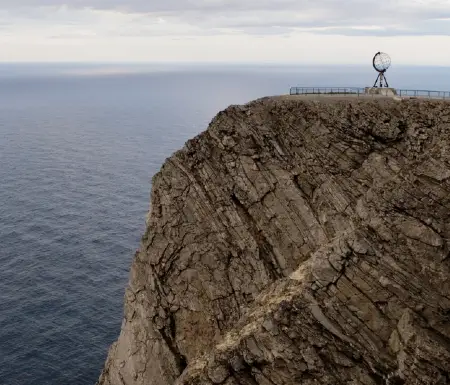
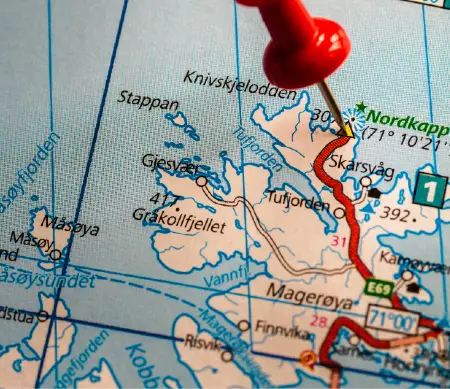
The first tourist on the North Cape Plateau was the Italian priest Francesco Negri, who visited in 1664. In the following centuries, mainly around 800, the North Cape became an extreme travel destination for noblemen. It was then visited by the King Oscar II of Norway and Sweden and by the German Kaiser Wilhelm II.
North Cape became popular with wealthy travelers in the late 1800s after Thomas Cook & Son began arranging tours to the destination. In the mid-1950s the road to the North Cape was built, which involved crossing the Magerøysundet strait by ferry. In the 1990s the tunnel was built, which facilitated the success of the North Cape myth.
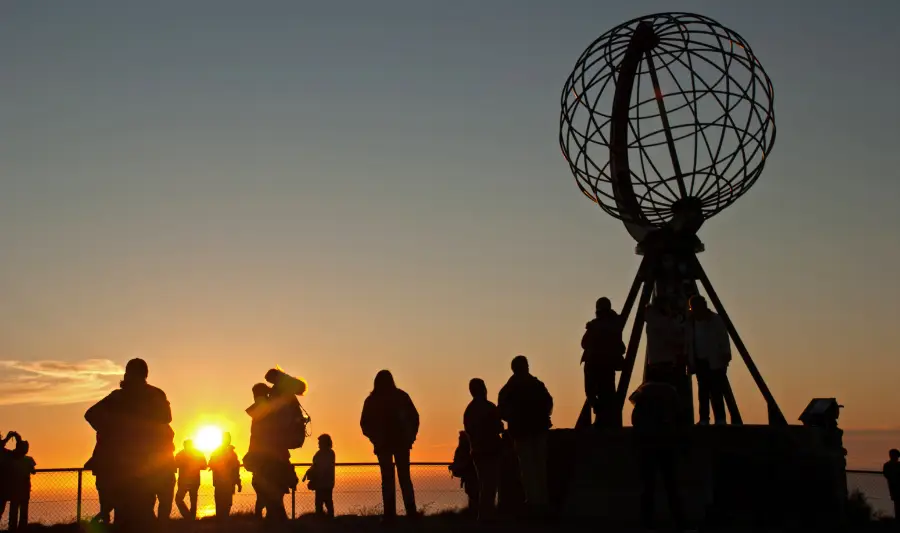
Is the North Cape really the northernmost point in Europe?
North Cape (Nordkapp) is the northernmost point in Europe that can be reached by car, while the true northernmost point in Europe is the neighboring Knivskjellodden Cape, which actually extends 1,450 m further north.
But both of these points are located on an island, which makes it inaccurate to say that they are the northernmost points of mainland Europe. So, what is the true northernmost point of mainland Europe?
The true northernmost point of mainland Europe is Cape Nordkinn (Kinnarodden) which lies about 5.7 km further south and about 70 km to the east of Nordkapp. And poor Cape Nordkinn is a desolate and unknown place. Reaching it is difficult: it is a rough, impressively beautiful, extreme place.
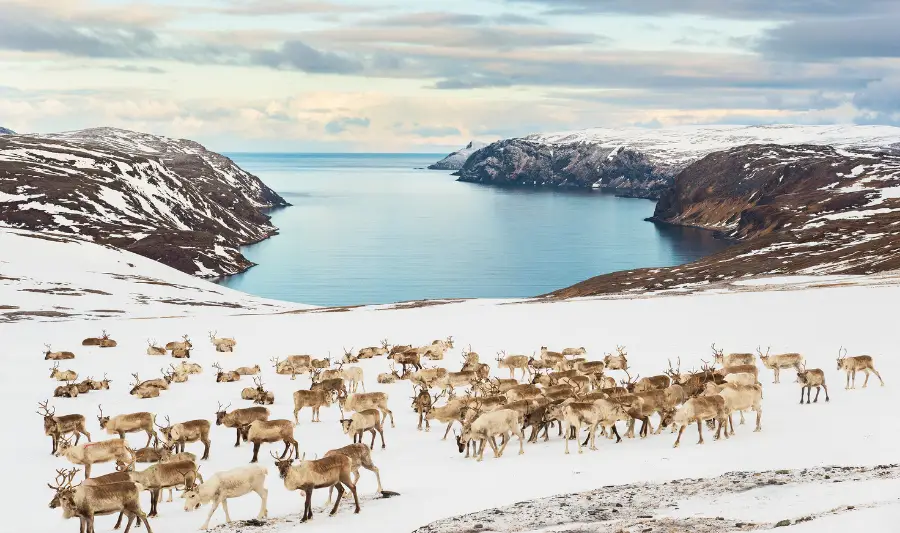
You can get there with a 24 km-long hike (one way), and it takes more than two days to get there and back. There is no actual trail, only erected poles and cairns at rather long distances apart. The terrain is rocky, challenging and with frequent fog it is hard to find your way around. Cape Nordkinn (GPS: 71.13308, 27.65417) is a lonely but impressive place that can only be visited following at least a full-day hike from Mehamn and one day back.
The trail starts right from the parking lot of the small Mehamn airport, on the left side of the building. Consider that you should arrive in Mehamn at least the day before and leave at least the day after the hike. There are a couple of good (and rather quaint) hotels in Mehamn: the Mehamn Arctic Hotel and the Adventure Camp Mehamn.
While the northernmost point of Europe including islands, is hundreds of kilometers further north, on Franz Josef Land (Russia) and then on the Svalbard Islands (Norway).
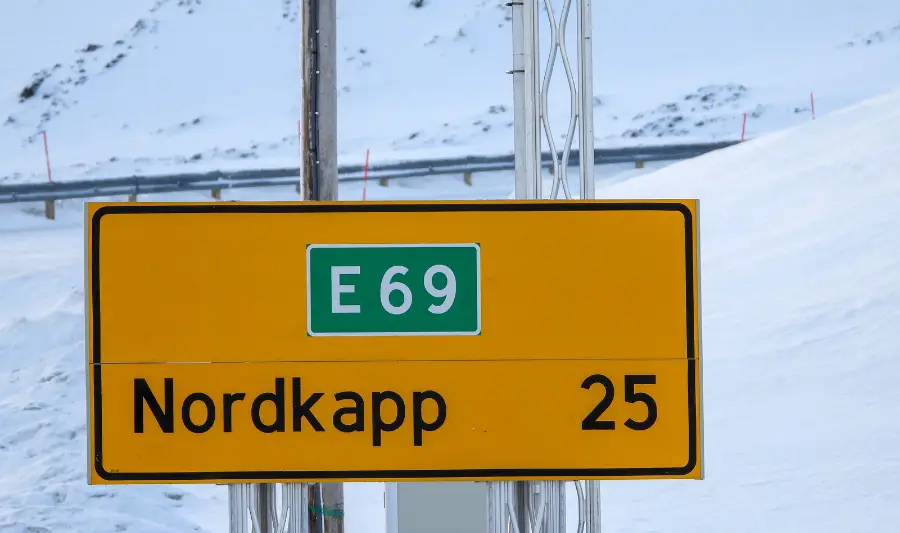
How to get to the North Cape by Car or Motorcycle
Nordkapp is easily accessible by driving along the E6 from Alta (or Karasjok if you are coming from Finland) to Olderfjord, from here you will take the E69 which will take you straight to Nordkapp (the road ends there).
From Olderfjord to Nordkapp it is 129 km, and the road is in good condition. In summer it is easy to drive and the road is very scenic, through the dramatic landscape of the Magerøya island, without trees and characteristic of the lands of the far north. You will drive through 5 tunnels, including the Nordkapptunnelen (North Cape Tunnel), one of the longest and the northernmost of the subsea road tunnels in Norway, which is 6.875 meters long and reaches a depth of 212 meters below sea level. Since 2012, there is no longer a toll for passing through the tunnel. The road in the tunnel has a gradient of 9%, both downhill and uphill, so reduce your speed and drive carefully.

Driving towards Nordkapp in winter will be an experience in itself, because the weather conditions can be very harsh, with lots of snow, very strong winds, ice and zero visibility. The road to North Cape is officially closed in winter, you cannot drive on your own in these rough lands. But you can still get to the North Cape, because during the winter the road is operated by convoy driving. Trust me, it’s a crazy experience! I drove to the North Cape in February, and it’s an adventure worth doing!
Driving in a convoy means that a snow plow drives in front of a convoy of cars, and at the end of the convoy there is generally another snow plow or safety car. The convoy departs at scheduled times, from Skarsvåg intersection to North Cape: at 11:00 (private cars and buses) and 12:00 (Hurtigruten buses and the public bus). So, you should be in time to drive with the 11 am convoy. There is an additional convoy called Aurora Convoy which leaves at 7:30 pm. The return from North Cape is at 13:00, 13:45 and 21:45 (Aurora Convoy).
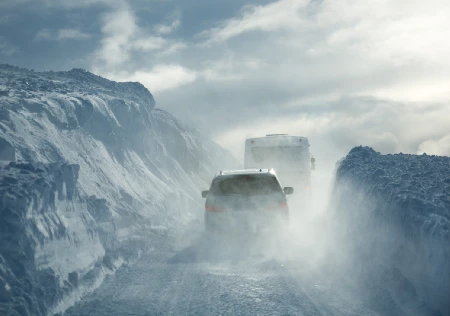
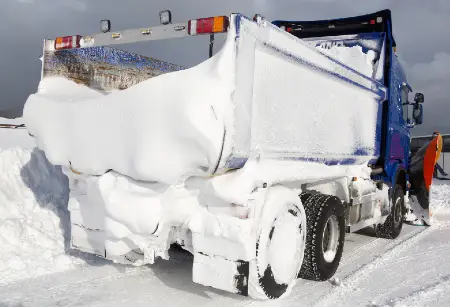
Make sure you have enough fuel as the only petrol station is in Honningsvåg. Drive carefully and never leave the convoy. Sometimes the weather could be very bad, and the only thing you can do is wait for it to get better. So take it easy, it’s the far north. The road is very exposed to bad weather and for safety reasons the road may be closed for the whole day, so it is preferable to have a couple of extra days when traveling in these areas.
How to get to the North Cape by Bus
Getting to Nordkapp by bus is a long but feasible journey. From Alta you can get to Honningsvåg, there are two two daily buses. There are also buses from Karasjok and connections from Rovaniemi operated by Eskelisen Lapinlinjat.
To get to Nordkapp from Tromsø you have to take a bus to Alta, stay overnight and then take the bus to Honningsvåg the next morning. There are no direct connections.
From Honningsvåg there is a bus called North Cape Express and marked Line 406, which departs daily near the Tourist Information at 11:30 (11:45 in summer) and arrives at 12:15 in North Cape. The return is at 13:45 and arrives in Honningsvåg at 14:30. The ticket can be done on the bus and the price is quite expensive, starting from 750 NOK per person.
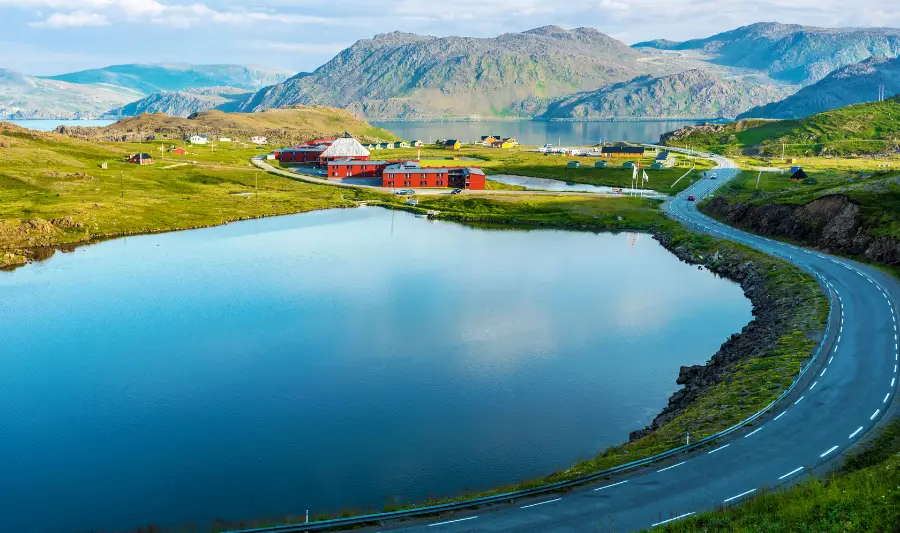
How to get to the North Cape by Plane
Nordkapp can be reached from Tromsø by plane, flying to Honningsvåg Airport (30km from North Cape) or the more popular Lakselv Airport (193km from North Cape) or Alta Airport.
Alta Airport is the most convenient solution, as it is an international airport, with frequent and cheaper connections to Oslo and Tromsø. If you want to fly and drive to the North Cape, your best bet is to fly to Alta and rent a car there. But remember to book your car online well in advance. You can check prices and availability on Rentalcars or Discovercars.
How to get to the North Cape by Ship
Many tourists visit Nordkapp on a cruise. The famous coastal cruise Hurtigruten calls Honningsvåg, as well as many cruise ships. Some Hurtigruten ships also carry cars, but not RVs or caravans. From Honningsvåg you can take the bus to the North Cape.
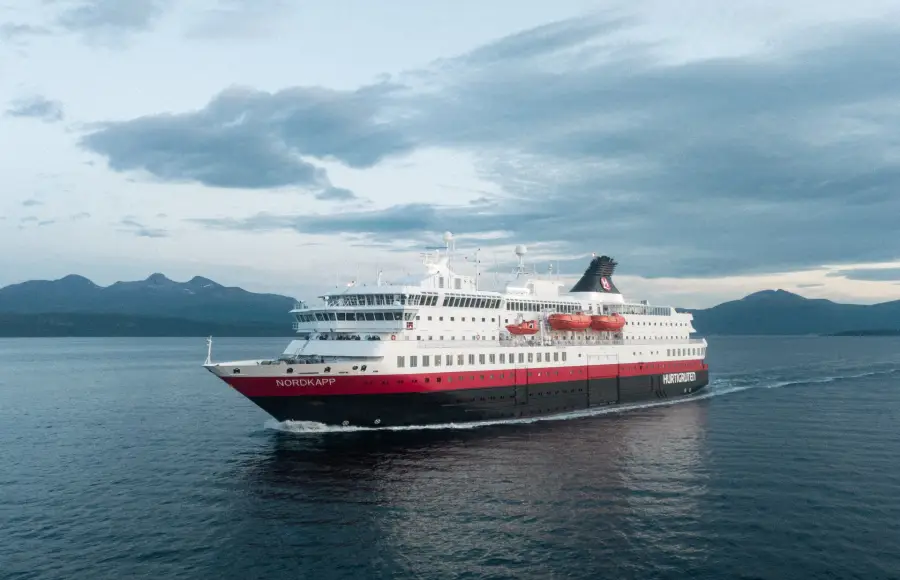
How to get to the North Cape by Bicycle
Getting to Nordkapp by bike is an epic experience, but it requires the right preparation and training. Keep in mind that the weather conditions can get harsh already from Smørfjord, about 130 km from the North Cape. The last stretch, from Honningsvåg to the North Cape may be tougher than you think. Winds could be very strong, also expect something like strong gale 7-9 Bft with much stronger gusts.
The tunnel is downhill for the first 3 km, watch out for the ice and moderate your speed. Obviously remember good equipment, thermal clothing, and enjoy the trip, it will be unforgettable! Cyclists or those arriving on foot get free access to the North Cape – don’t forget to sign the cyclists’ guest book in the visitor center!
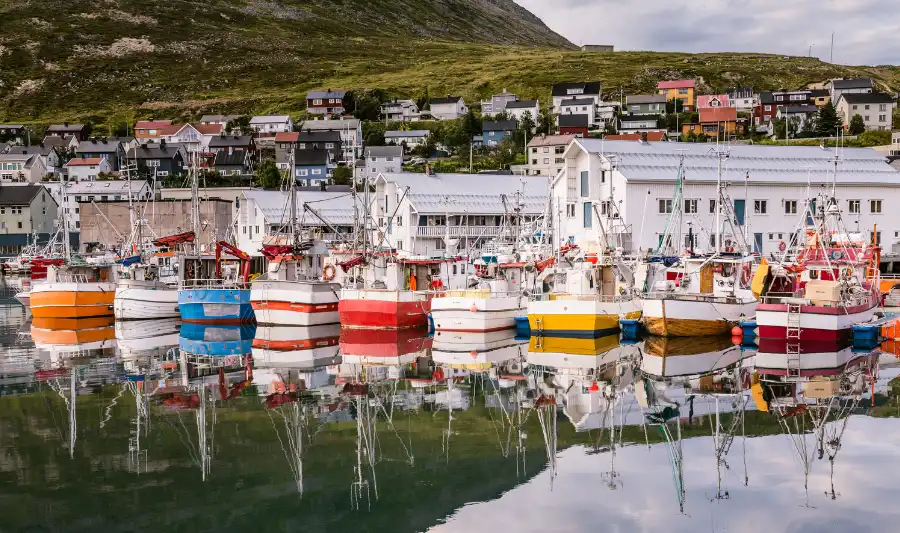
Hotels and Accommodations in Nordkapp
To visit Nordkapp you will need to stay in the surrounding area, the scenic Magerøya Island. Here the main town is Honningsvåg which boasts some good hotels, such as Arctic Hotel Nordkapp, The View and the famous Scandic Bryggen, all of which offer comfortable accommodation with great breakfast included in the price.
Also very distinctive is Nordkapp Camping, which offers affordable accommodation in beautiful cottages with a view and the picturesque Sarnes Seaside Cabins, located in typical fishermen’s cottages, with unbeatable views of the fjord.
It is worth making your way to the old and remote fishing village of Gjesvær, where colonies of seals, puffins and other water birds can often be seen, to stay at Nygård Apartments, which offers great accommodation in a perfect spot for spotting the Northern Lights.
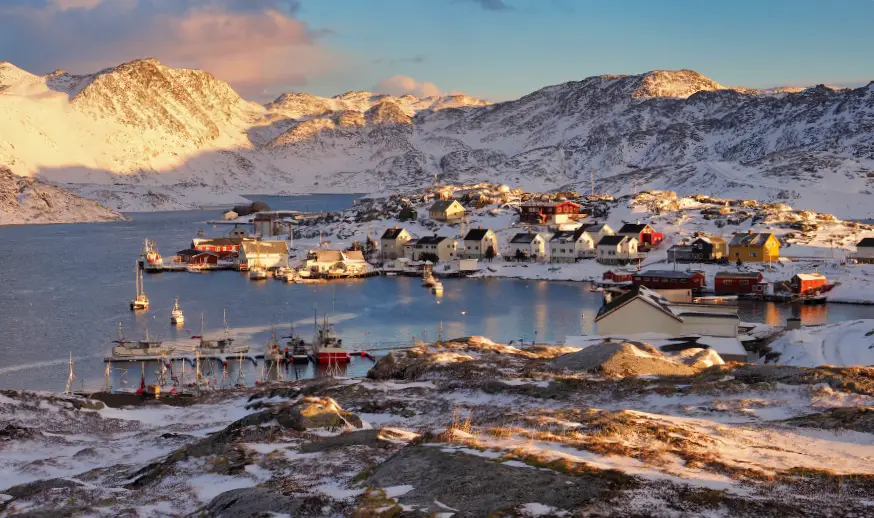
Nordkapp Camping: Is it possible to camp in North Cape?
No, it is not possible to camp freely in Nordkapp.
If you are traveling with a camper or caravan, then you can camp in your vehicle for free in the Nordkapp car park. It is not possible to camp with tents or other solutions, so the best solution is to stay overnight in the nearby campsites or hotels, such as Nordkapp Camping or Nordkapp Caravan og Camping, or Arctic Hotel Nordkapp in Honningsvåg.
Sleeping in a car in the North Cape in winter is impossible and dangerous, while in summer it is very difficult due to the midnight sun and the noise of the many tourists who crowd the parking lot at any time of day or night.
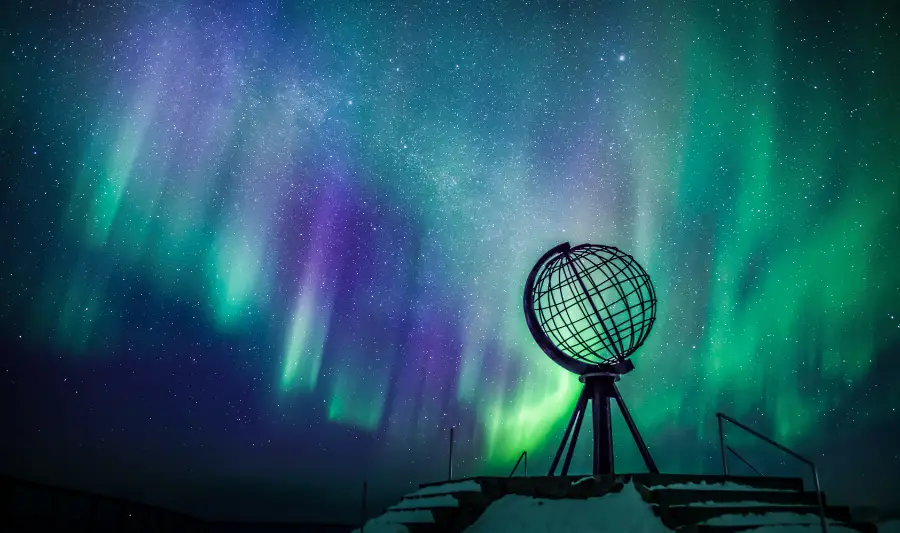
Things to Do and See in Nordkapp
Getting to the North Cape is an experience in itself. You cannot describe the emotion you feel once you reach the iconic globe, you have to live it!
The North Cape Globe is one of the most iconic places in the world. In winter, waiting for the Northern Lights in the North Cape or in the nearby villages of Honningsvåg, Skarsvåg or Gjesvær is one of the most memorable things to do at least once in a lifetime.
While in the summer you can enjoy the magic of the midnight sun, with the wild waves crashing against the cliff, in the blue ocean hundreds of meters below. You will feel the pure wind from the North in your hair, the calls of sea birds, and you will be mesmerized by the endless horizon.
This is North Cape.
For the rest, nothing special. Once in the North Cape you will find a huge parking lot, a radar station (the big house with a kind of golf ball on the roof) and right next to it, the Nordkapphallen.
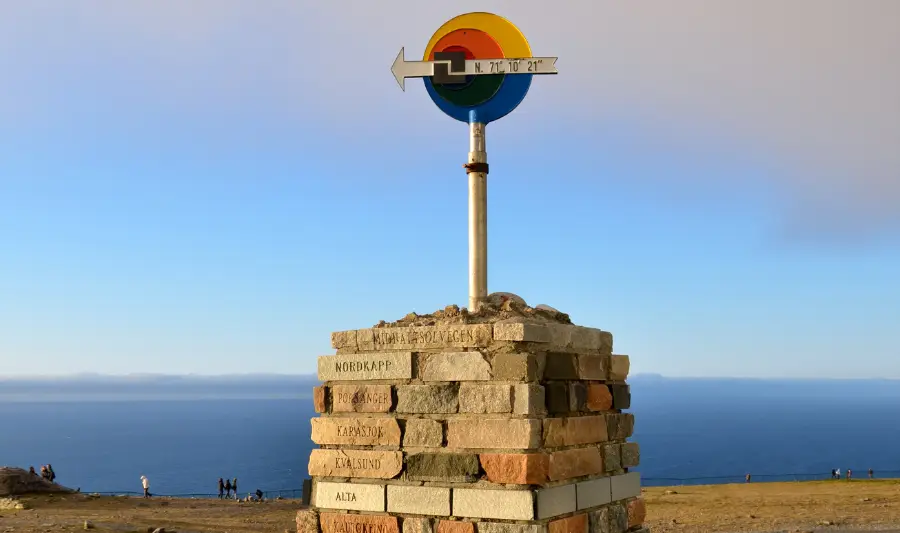
Nordkapphallen (The North Cape Hall) is Nordkapp’s visitor center, and here you can see an exhibit on the history of Nordkapp and that of the famous Battle of the North Cape, a massive naval battle that took place on December 26, 1943, during WWII, between the German battleship Scharnhorst and the British Royal Navy battleship HMS Duke of York, escorted by British and Norwegian cruisers and destroyers. It was the last naval battle between Germany and the United Kingdom, which ended with the sinking of the German battleship.
After the history binge, you can go to the Nordkapphallen cinema, where you can see a film about the four seasons at the North Cape, made with the spectacular Supervideograph wide-screen system. You can also see St. Johannes Kapell, which is the world’s northernmost ecumenical chapel (which seems to be quite popular for weddings), a post office (where you can send postcards with the iconic NORDKAPP 71°10′21″N stamp), a restaurant and a café with a view and a large souvenir shop.

Near the Nordkapphallen you can see the famous sculptures called “Children of the World”, made between 1988 and 1989 by the artist Simon Flem Devold and based on drawings made by 7 randomly selected children from 7 countries around the world. Right next to it is the “Mother and Child” monument by sculptor Eva Rybakken. On the opposite side is a granite column celebrating the visit of King Oscar II of Norway and Sweden, which took place in 1873. Also nearby is a memorial of the visit of German Kaiser Wilhelm II in 1891.
If you have enough time, are fit enough, and with the right equipment, I recommend that you take the hike to Knivskjellodden rather than come to the North Cape car park. That’s really wow! Read on and you will find all the information you need about it.
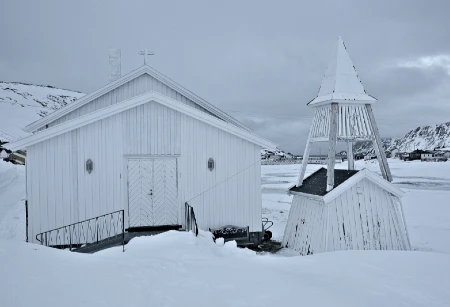
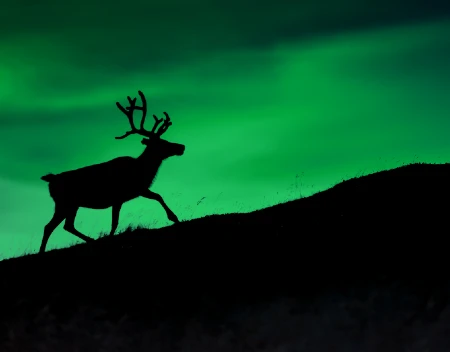
Visit Nordkapp in the Winter
Nordkapp in winter looks like a wild, desolate land, lashed by icy and powerful winds. If you love the polar lands, the true north, then you must go! It will always be dark, as winter is the polar night time, so you won’t see much of the view. But except for December and January, you’ll have enough twilight hours in the morning to enjoy the view and take great photos.
In winter you will be able to see the Northern Lights in Nordkapp, usually after 7pm and until 3am, these are the best times. However, the visibility from Nordkapp could be bad, because the weather there is quite harsh. Better to spot the Northern Lights near your accommodation, towards Gjesvær, Honningsvåg or Skarsvåg, where you will have clearer skies.
Visit Nordkapp in the Summer
Visiting Nordkapp in the summer allows you to make the most of the wonderful landscape, the view of the Barents Sea and the possibility of hiking towards Knivskjellodden. This season is the most popular, so expect to find many tourists who come here with cruises, buses, campers and lots of motorbikes!
The weather is good, you can drive easily, but remember to bring warm clothing – it could be colder than you think, and it could be very windy.
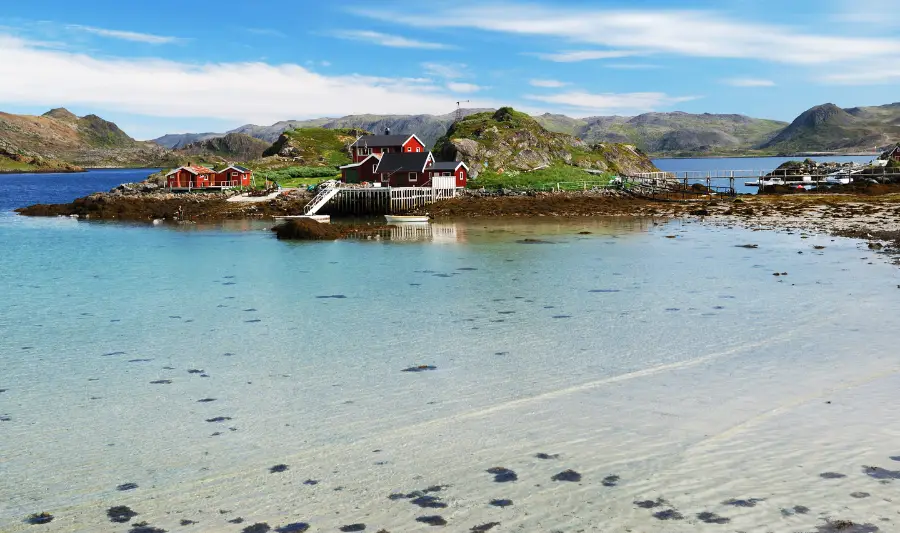
Nordkapp Daylight Hours: Sunrise and Sunset Calendar
If you are wondering how many hours of daylight there will be in the month you visit Nordkapp, then these notes will be super useful:
Nordkapp in January
- 01/01: The sun is always down
- 1/15: The sun is always down
Nordkapp in February
- 01/02: 09:18 – 13:42
- 02/15: 07:57 – 15:04
Nordkapp in March
- 01/03: 06:45 – 16:12
- 03/15: 05:35 – 17:15
Nordkapp in April
- 01/04: 05:11 – 19:29
- 15/04: 03:58 – 20:35
Nordkapp in May
- 01/05: 02:20 – 22:07
- 15/05: The sun is up all day
Nordkapp in June
- 01/06: The sun is up all day
- 15/06: The sun is up all day
Nordkapp in July
- 01/07: The sun is up all day
- 15/07: The sun is up all day
Nordkapp in August
- 01/08: 00:56 – 23:49
- 08/15: 03:01 – 21:41
Nordkapp in September
- 01/09: 04:28 – 20:05
- 09/15: 05:29 – 18:54
Nordkapp in October
- 01/10: 06:37 – 17:35
- 15/10: 07:39 – 16:25
Nordkapp in November
- 01/11: 08:05 – 13:55
- 11/15: 09:44 – 12:18
Nordkapp in December
- 01/12: The sun is always down
- 12/15: The sun is always down
The midnight sun in Nordkapp can be seen essentially from mid-May to early August.
The cold, dark polar night starts from early December until the end of January. In February and November you can experience the so-called Polar Twilight, so there is then no true daylight at the solar culmination, but may still be enough light for most normal outdoor activities because of light scattering and refraction.
The months from November to the end of March are the best to see the Northern Lights in Nordkapp.
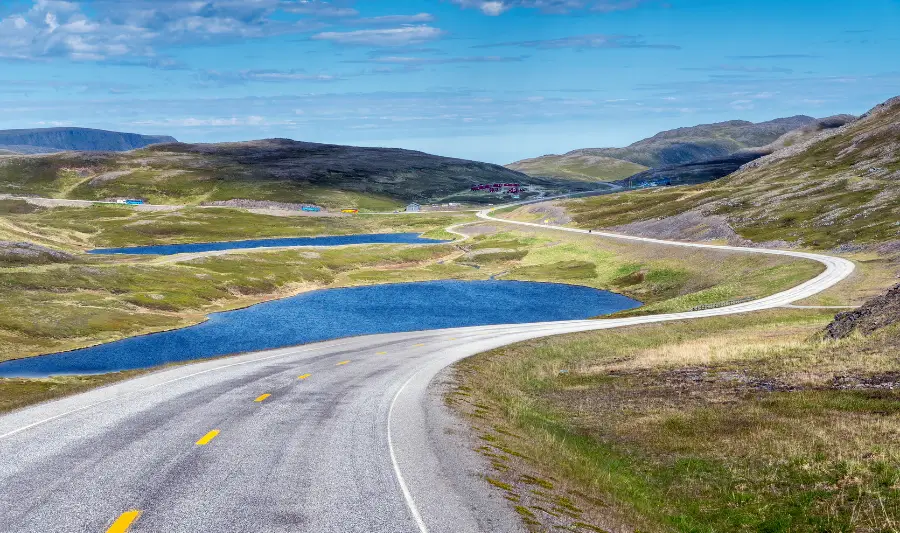
How much time do you need to visit Nordkapp?
The beauty of getting to Nordkapp is the journey. So take your time, consider the endless photo stops along the way, and keep in mind that the weather may not be the best. If you travel to Nordkapp in the winter you will have few (or no) hours of daylight, and it can be quite tricky to drive to the North Cape, which takes a few hours longer than what Google Maps indicates.
So my advice is to arrive in the area (on Magerøya Island) the day before, stay overnight there, and then go early in the morning to the North Cape. If you only visit the North Cape (i.e. the famous area with the Globe and the parking lot) then in a couple of hours you could have done it, also because it could be very windy. At that point you could get back on the road and continue exploring the island, such as the quaint old fishing village of Gjesvær and Honningsvåg, and stay overnight in the area and then set off for Alta the next morning.
If you want to walk around the area, enjoy the midnight sun or wait for the Northern Lights, then you could stay there for hours.
Nordkapp Prices and Opening Hours
Entrance to Nordkapp is free.
Yes, you got it right. You can get to the North Cape and park in the large free car park. This has been going on since the beginning of 2021, because the Municipality of Nordkapp has won a long and gripping lawsuit against the company that owns Nordkapphallen. As a result of the decision of the Norwegian Court it is now possible to enter and park for free in Nordkapp. While admission to Nordkapphallen and its services is subject to a fee.
The ticket prices for the Nordkapphallen are:
- Adult: NOK 260
- Children 7 – 15 years: NOK 80
- Family (2 adults + 2 children): NOK 600
- Students: NOK 180
Nordkapp is accessible 24/7. You can arrive at the car park and visit the North Cape at any time you want, provided the road is open. In winter, traffic may be limited and you will have to respect the timetables of the convoys.
Nordkapphallen opening hours are:
- 01 January – 17 May: 11:00 – 15:00
- 18 May – 15 August: 11:00 – 01:00
- 16 August – 31 August: 11:00 – 22:00
- 01 September – 30 September: 11:00 – 17:00
- 01 October – 31 December: 11:00 – 15:30
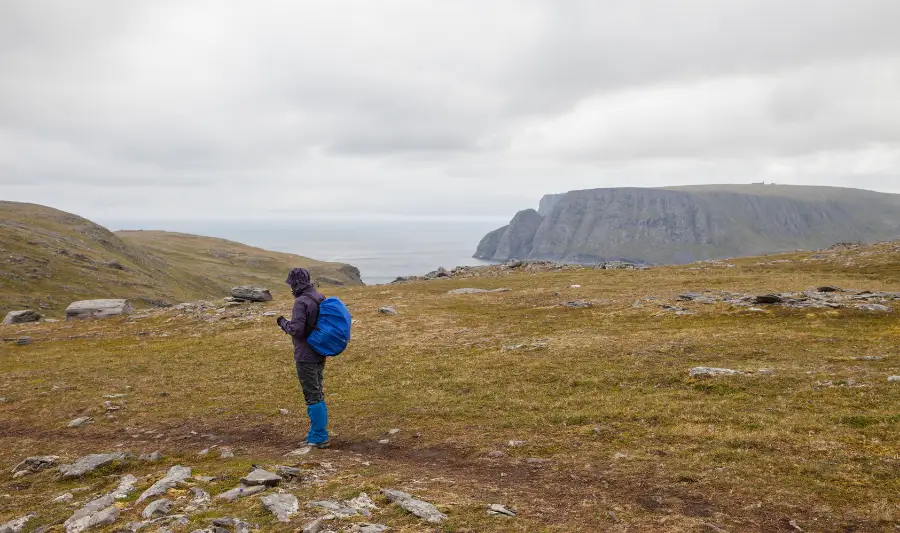
Hiking in Knivskjellodden: The real (unexplored) North Cape
The real northernmost point of Europe is not Nordkapp, but Knivskjellodden, located about 3 km west of Nordkapp, on a rather inaccessible cliff. This spot is 1457m further north than Nordkapp, but it is almost a secret as it is much less known. And unlike Nordkapp it is not touristy.
But it takes some effort to get there, as it is inaccessible to vehicles and the only way to get there is to hike along a 9km trail. The trail starts from a parking lot located about 6km south of Nordkapp (GPS: 71.12201, 25.70815).
You can leave your car there (for free) and follow the path to the tip of the promontory. The trail is waymarked by stones and red T’s. It will take you between 2.5 and 3 hours to get to Knivskjellodden, and at least as long to return. The hike is not particularly difficult, but you need to have good hiking boots and bring warm clothing, and maybe something waterproof to wear in case (not so uncommon) of rain.
Once you arrive at the Knivskjellodden you will see a tall beehive-shaped obelisk, which announces that you have reached the latitude 71°11’08” N. Open the box, inside you will find a guest book on which you can write your name. Note down your reference number from the book, so if you want you can go to Nordkapp Camping where you can request a certificate attesting your achievement (for a fee of 50 NOK).
Since the weather is unstable at this high latitude, it may take longer than expected, you may encounter fog or storm. It may be a good idea to leave a message detailing where you were going and what time you left in your car. The trail is accessible only in summer, and is usually snowbound (and hence impassable) from October (sometimes from mid-September) to May.